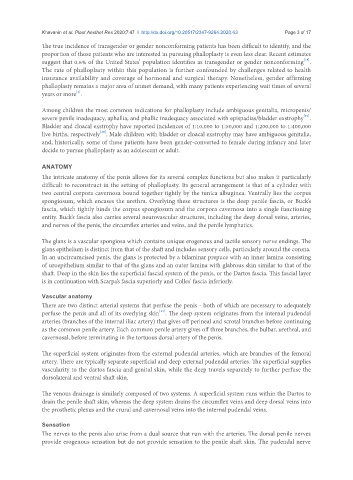Page 532 - Read Online
P. 532
Khavanin et al. Plast Aesthet Res 2020;7:47 I http://dx.doi.org/10.20517/2347-9264.2020.63 Page 3 of 17
The true incidence of transgender or gender nonconforming patients has been difficult to identify, and the
proportion of those patients who are interested in pursuing phalloplasty is even less clear. Recent estimates
[18]
suggest that 0.6% of the United States’ population identifies as transgender or gender nonconforming .
The rate of phalloplasty within this population is further confounded by challenges related to health
insurance availability and coverage of hormonal and surgical therapy. Nonetheless, gender affirming
phalloplasty remains a major area of unmet demand, with many patients experiencing wait times of several
[3]
years or more .
Among children the most common indications for phalloplasty include ambiguous genitalia, micropenis/
severe penile inadequacy, aphallia, and phallic inadequacy associated with epispadias/bladder exstrophy .
[19]
Bladder and cloacal exstrophy have reported incidences of 1:10,000 to 1:50,000 and 1:200,000 to 1:400,000
live births, respectively . Male children with bladder or cloacal exstrophy may have ambiguous genitalia,
[20]
and, historically, some of these patients have been gender-converted to female during infancy and later
decide to pursue phalloplasty as an adolescent or adult.
ANATOMY
The intricate anatomy of the penis allows for its several complex functions but also makes it particularly
difficult to reconstruct in the setting of phalloplasty. Its general arrangement is that of a cylinder with
two central corpora cavernosa bound together tightly by the tunica albuginea. Ventrally lies the corpus
spongiosum, which encases the urethra. Overlying these structures is the deep penile fascia, or Buck’s
fascia, which tightly binds the corpus spongiosum and the corpora cavernosa into a single functioning
entity. Buck’s fascia also carries several neurovascular structures, including the deep dorsal veins, arteries,
and nerves of the penis, the circumflex arteries and veins, and the penile lymphatics.
The glans is a vascular spongiosa which contains unique erogenous and tactile sensory nerve endings. The
glans epithelium is distinct from that of the shaft and includes sensory cells, particularly around the corona.
In an uncircumcised penis, the glans is protected by a bilaminar prepuce with an inner lamina consisting
of uroepithelium similar to that of the glans and an outer lamina with glabrous skin similar to that of the
shaft. Deep in the skin lies the superficial fascial system of the penis, or the Dartos fascia. This fascial layer
is in continuation with Scarpa’s fascia superiorly and Colles’ fascia inferiorly.
Vascular anatomy
There are two distinct arterial systems that perfuse the penis - both of which are necessary to adequately
[21]
perfuse the penis and all of its overlying skin . The deep system originates from the internal pudendal
arteries (branches of the internal iliac artery) that gives off perineal and scrotal branches before continuing
as the common penile artery. Each common penile artery gives off three branches, the bulbar, urethral, and
cavernosal, before terminating in the tortuous dorsal artery of the penis.
The superficial system originates from the external pudendal arteries, which are branches of the femoral
artery. There are typically separate superficial and deep external pudendal arteries. The superficial supplies
vascularity to the dartos fascia and genital skin, while the deep travels separately to further perfuse the
dorsolateral and ventral shaft skin.
The venous drainage is similarly composed of two systems. A superficial system runs within the Dartos to
drain the penile shaft skin, whereas the deep system drains the circumflex veins and deep dorsal veins into
the prosthetic plexus and the crural and cavernosal veins into the internal pudendal veins.
Sensation
The nerves to the penis also arise from a dual source that run with the arteries. The dorsal penile nerves
provide erogenous sensation but do not provide sensation to the penile shaft skin. The pudendal nerve

